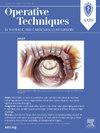用尸体股骨重建胸骨、柄骨和胸锁关节:一种新方法
Q3 Medicine
Operative Techniques in Thoracic and Cardiovascular Surgery
Pub Date : 2025-06-01
DOI:10.1053/j.optechstcvs.2025.01.001
引用次数: 0
摘要
目的:介绍一种利用尸体股骨异体移植重建胸骨和胸骨锁骨关节的新技术。病例描述:一名58岁男性,患14.8厘米的1级胸骨软骨肉瘤,需要广泛切除和重建。目的是建立半刚性重建,保留胸锁关节的一些活动能力,以获得最佳的患者生活质量。在适当的肿瘤切除后,将尸体股骨塑成新胸骨轮廓,并使用多种固定技术将其固定在锁骨和残余的基底胸骨上。最终假体由双侧胸肌瓣覆盖。病人的术后过程平安无事。在16个月的随访中,患者能够进行正常的活动,包括工作和自我护理,无移植物衰竭、骨折和感染的迹象,美容效果良好。结论:我们成功地使用生物假体对大型低级别软骨肉瘤进行了半刚性胸骨和胸锁骨关节重建,患者短期预后良好,功能保存良好。多学科的护理对这种复杂的胸壁重建术至关重要。长期随访将是必要的,以确定建设的耐久性随着时间的推移。本文章由计算机程序翻译,如有差异,请以英文原文为准。
Reconstruction of the Sternum, Manubrium, and Sternoclavicular Joints With Cadaveric Femur: A Novel Approach
Objective: To describe a novel sternal and sterno-clavicular joint reconstruction technique using cadaveric femoral allograft. Case Description: A 58-year-old male presented with 14.8 cm Grade 1 sternal chondrosarcoma requiring extensive resection and reconstruction. The goal was to create a semi-rigid reconstruction preserving some mobility of the sternoclavicular joint for optimal patient quality of life. After appropriate oncologic resection, a cadaveric femur was fashioned into a neo-sternal profile and anchored to the clavicles and residual basilar sternum using multiple fixation techniques which are discussed below. The final prosthesis was covered by bilateral pectoralis muscle flaps. The patient had an uneventful postoperative course. On 16 months follow-up, the patient was able to carry out normal activities including work, and self-care, with no evidence of graft failure, fracture, and infections and good cosmetic outcome. Conclusions: We have successfully performed a semi-rigid sternal and sternoclavicular joint reconstruction for large, low-grade chondrosarcoma using bio-prosthesis with good short-term patient outcomes and preservation of functionality. Multidisciplinary care is essential for the performance of such complex chest wall reconstructions. Longer-term follow-up will be necessary to determine the durability of the construct over time.
求助全文
通过发布文献求助,成功后即可免费获取论文全文。
去求助
来源期刊

Operative Techniques in Thoracic and Cardiovascular Surgery
Medicine-Surgery
CiteScore
1.40
自引率
0.00%
发文量
59
期刊介绍:
Operative Techniques in Thoracic and Cardiovascular Surgery provides richly illustrated articles on techniques in thoracic and cardiovascular surgery written by renowned surgeons. Each issue presents cardiothoracic topics in adult cardiac, congenital, and general thoracic surgery. Each specialty of interest to the thoracic and cardiovascular surgeon is explored through two different approaches to a specific surgical challenge. Each article is thoroughly illustrated with original line drawings, actual intraoperative photos, and supporting tables and graphs.
 求助内容:
求助内容: 应助结果提醒方式:
应助结果提醒方式:


